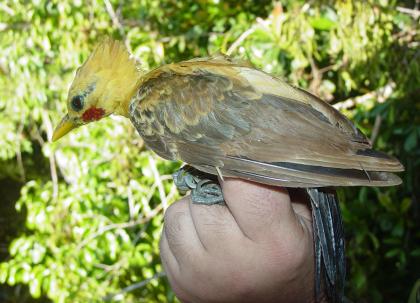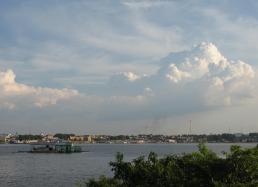Blog #9: Heading Home
It’s the last morning at the Maraã site, our third field site, which is situated on a small river flowing into the north bank of the Japurá River. Our other sites were on the south bank of the river, and many of these south-bank birds, which that have long been considered the same species across Amazonia, actually look quite different from the bird found at this north-bank site (see above bird photo.) When we return home and have the opportunity to analyze DNA sequences in the labs at the Goeldi and Field Museum, we’ll have new data on just how closely or distantly related these species are.
I suspect that we’ll confirm what we and others have found on previous expeditions: many Amazonian bird species long considered to be geographically widespread actually have both morphological (physical) and genetic differences. This information supports the idea that Amazonian Rivers are barriers to the movement of many birds that specialize on living in Terra Firme forest.
So what this means is that while some Amazonian Terre Firme bird populations may have similar physical traits because they share a common ancestor, they have been evolving separately for hundreds of thousands of years, isolated on their own little interfluvia (the “islands” of Terra Firme forest between major Amazonian Rivers) and are therefore genetically different.
The specimens that our team has collected on this trip from both banks of the Rio Japurá will help us tease apart the importance of this river in differentiating bird populations in the region. Not only will this help us understand the evolutionary history of Amazonian birds in general, but it will also help us identify the range of these isolated populations, which has big implications for targeting the geographical areas in greatest need of conservation action.
But I’m getting ahead of myself. First, we need to get our specimens back to the museums' laboratories where we can study the specimens in comparison to other material housed in the collections and where we can collect and analyze genetic data. So after a quick stop at a river island at the mouth of Lago Cumapi (near Maraã), we headed back down the Rio Japurá for the overnight trek across the Rio Solimões to Tefé. Since we began our expedition by traveling to our furthest collecting site and working our way back downstream, we now have a much shorter boat ride back to Tefé, where we’ll board a plane to begin our journey home.
At dawn on August 3rd, the noises of other nearby boats awoke us, and we found ourselves docked along the bank of Tefé Lake, just across from the city (see Photo #1 below.) We spent much of the day preparing our final few specimens and packing up our gear. In late afternoon we all showered, and then the captain drove the boat over to the city dock, where we all disembarked and headed into town for a celebratory pizza dinner—a welcome change from our daily staple diet of rice, beans, and farinha (see Photo #2 below).
That night we slept on the boat and then took a flight to Manaus the next day. This is where John and I parted ways with the Goeldi team. They headed back to Belém, and we headed to the hotel where we’d stayed on our arrival in Manaus earlier in July. John and I finally found time that afternoon to tour the Manaus Opera House, and we met colleagues Mario Cohn Haft and Rita Mosquita, who live and work in Manaus, for a fantastic Amazonian fish dinner, where talked about birds and Brazil well into the evening. The next morning we returned to the airport and flew back to the U.S.
It has been a highly successful expedition with a great team (see Photo #3 below)! We’ve had a lot of fun and have also worked extremely hard. The data and specimens that we’ve collected will provide materials for research not only for our work for many years, but for research projects of many other scientists well into the future. And we look forward to more Amazonian expeditions soon, where we can continue to study birds and parasite species to understand their evolutionary history and to identify more micro-regions of diversity in need of conservation action!
See you back at the museum!
Jason







